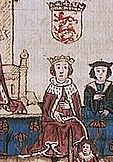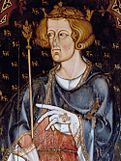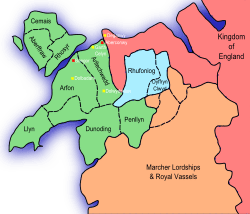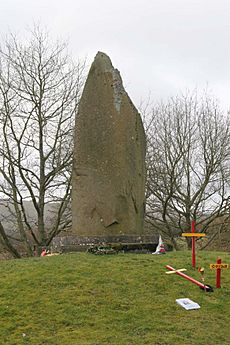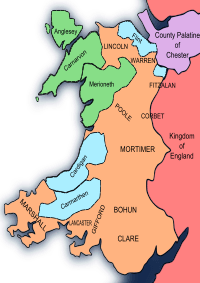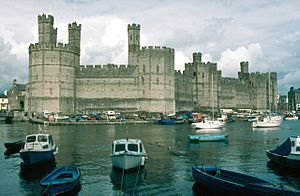Conquest of Wales by Edward I facts for kids
The conquest of Wales by Edward I happened between 1277 and 1283. It's sometimes called the Edwardian Conquest of Wales. This is to tell it apart from earlier, smaller Norman conquests. In two main wars, King Edward I of England took control of Wales. He first greatly reduced the land of Llywelyn ap Gruffudd, known as "Llywelyn the Last". Then, he completely took over Llywelyn's lands and other Welsh areas.
By the 1200s, Wales was split. Some parts were ruled by native Welsh princes. Other parts were controlled by Anglo-Norman lords called Marcher lords. The strongest Welsh area was Gwynedd. Its princes had taken control of most of Wales. They made other Welsh princes their helpers and used the title Prince of Wales. English kings had tried many times to control Wales. But it was Edward's war against Llywelyn, the last native Prince of Wales, that finally succeeded for good.
Most of the conquered land became royal property. Later, this land was given to the heir to the English throne. This heir also received the title Prince of Wales. Other parts of Wales were given to Edward's supporters. These became new Marcher lordships. Wales wasn't fully joined with the Kingdom of England until the Laws in Wales Acts 1535–1542. But Edward's conquest ended Welsh independence.
Contents
Background: Wales in the Middle Ages
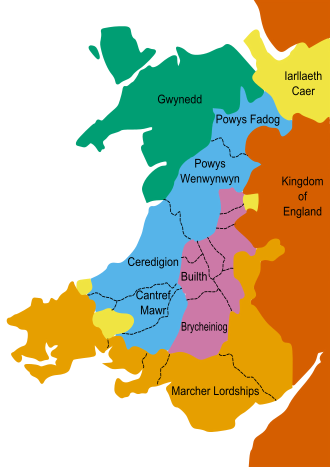
After the Normans took over England in 1066, they invaded Wales. They took much of the land. They set up special areas called Marcher lordships. These lords were almost independent but loyal to the English king. However, Welsh areas like Gwynedd, Powys, and Deheubarth survived. By the late 1000s, the Welsh began to push back the Normans. Over the next century, the Welsh fought back and forth. English kings, especially Henry II, tried to conquer Wales. But by the late 1100s, Marcher lordships were mostly in the south and southeast.
Gwynedd became the strongest power in Wales in the early 1200s. Powys and Deheubarth became its helper states. Gwynedd's princes then started using the title "Prince of Wales". But wars with England in 1241 and 1245 weakened Gwynedd. A fight over who would be king also hurt them. This allowed Henry III to take Perfeddwlad, the eastern part of Gwynedd.
However, from 1256, Gwynedd became strong again under Llywelyn ap Gruffudd. He became known as "Llywelyn the Last". He fought Henry and took back Perfeddwlad. The Treaty of Montgomery in 1267 brought peace. Llywelyn agreed to show loyalty to the English king. In return, Henry recognized Llywelyn as Prince of Wales. He also accepted Llywelyn's control of Perfeddwlad. But small fights continued between Llywelyn and some Marcher Lords. These included Gilbert de Clare and Roger Mortimer.
Edward's Conquest of Wales
Why the War Started
Henry III died in 1272. His son, Edward I, became king. Henry had been a weak ruler. Edward was strong and a good military leader.
In 1274, problems grew between Llywelyn and Edward. Gruffydd ap Gwenwynwyn of Powys and Llywelyn's younger brother, Dafydd ap Gruffydd, switched sides. They went to Edward for protection. Also, Llywelyn kept fighting with the Marcher Lords. One big issue was Roger Mortimer's new castle at Cefnllys. Because of these problems, Llywelyn refused to meet Edward in Chester in 1275. He was supposed to show loyalty there, as agreed in the Treaty of Montgomery.
Edward was also upset because Llywelyn planned to marry Eleanor. She was the daughter of Simon de Montfort. Simon had led a rebellion against Edward's father. In November 1276, Edward declared war on Llywelyn. At first, Edward just wanted to control a disobedient helper. He didn't plan a full conquest.
The 1277 Invasion
Early in 1277, Edward sent troops into south and mid-Wales. These were paid soldiers and Marcher lords' men. They did very well. Many Welsh rulers didn't like Llywelyn's control. So, they gave up and joined the English. In July 1277, Edward led a large army into North Wales. He had 15,500 soldiers, including 9,000 Welshmen from the south. This army was gathered through a traditional call for soldiers.
The army marched from Chester into Gwynedd. They camped at Flint, then Rhuddlan, and Deganwy. They likely caused much damage as they went. Ships from the Cinque ports helped by sea.
Llywelyn soon saw he couldn't win. He quickly gave up. There was no major battle in this campaign. Edward decided to make a peace deal instead of a full conquest. He might have been running low on men and supplies by November 1277. Also, his goal wasn't to completely conquer Llywelyn's lands at that time.
Treaty of Aberconwy
The Treaty of Aberconwy was signed in November 1277. Llywelyn was left with only the western part of Gwynedd. But he was allowed to keep the title of Prince of Wales. Eastern Gwynedd was split between Edward and Llywelyn's brother, Dafydd. The rest of the lands that had been loyal to Llywelyn now belonged to Edward.
Because of this, Deheubarth, Powys, and mid-Wales changed. They became a mix of lands directly controlled by the king and English-friendly areas. Edward's victory was complete. It greatly shifted power and land in Wales to Edward. Edward now had more direct control over Welsh areas than any English king before him.
The 1282–83 Campaign
War started again in 1282. This was because Llywelyn's brother, Dafydd, rebelled. He was unhappy with what Edward had given him in 1277. Dafydd launched attacks with Welsh rulers in Deheubarth and North Powys. These rulers had been Llywelyn's helpers until 1277. Now they were Edward's. Llywelyn and other Welsh leaders joined in. This war was very different from the 1277 campaign. It became a national fight with wide support among the Welsh. They were especially angry about Edward trying to force English law on them. Edward soon saw this as a war to conquer Wales, not just to stop a rebellion.
The English attacked from three sides. Edward led his army into North Wales, using the same path as in 1277. Roger Mortimer fought in mid-Wales. The Earl of Gloucester advanced with a large army in the south. At first, the Welsh were successful. In June 1282, Gloucester was defeated at the Battle of Llandeilo Fawr. Edward replaced him with William de Valence. Valence raided in the south but couldn't find a Welsh army to fight.
Edward then faced a problem in mid-Wales. His commander there, Roger Mortimer, died in October. On November 6, while peace talks were happening, Luke de Tany attacked. He was Edward's commander in Anglesey. Tany and his men crossed a bridge they had built to the mainland. But the Welsh ambushed them. They suffered heavy losses at the Battle of Moel-y-don.
However, the war turned in Edward's favor. Llywelyn unexpectedly marched out of North Wales towards Builth in mid-Wales. He was led into a trap and killed at the Battle of Orewin Bridge on December 11, 1282. Edward used this lucky event to his advantage. He raised a new army and marched into Snowdonia in January 1283. He captured Dolwyddelan Castle, a key Welsh stronghold. At the same time, de Valence advanced from Cardigan into Meirionnydd in the south. The pressure from both sides was too much for the Welsh. The conquest of Gwynedd was finished in June 1283. Dafydd, who had become prince after his brother's death, was captured. Dafydd was taken to Shrewsbury and executed as a traitor that autumn.
After the Conquest
New Borders and Laws
Edward divided the Welsh lands. Some he kept for himself, under direct royal control. Others he gave to his supporters. These became new Marcher lordships. For example, the Earl of Lincoln received the lordship of Denbigh. Edward's Welsh allies also got their lands back. But they now held them under English feudal rules. For instance, Owain ap Gruffydd ap Gwenwynwyn received his family lands as the lordship of Powys. He became known as Owen de la Pole.
The lands Edward kept were organized under the Statute of Rhuddlan in 1284. This law said these lands were "joined" to the English crown. But they didn't become part of the Kingdom of England itself. They were the King's personal property. In 1301, they were given to Edward's son, Edward of Caernarfon. He was the future Edward II. He received the title "Prince of Wales". From then on, these lands and the title usually went to the heir to the throne.
The Statute of Rhuddlan divided the royal lands into six counties. These were like English counties and run by royal officials. The Statute also made English common law the rule in Wales. But some local Welsh customs were still allowed. For example, Welsh law was still used for some civil cases, like inheriting land. But there were changes. For instance, illegitimate sons could no longer claim part of the inheritance, which Welsh law had allowed.
The rest of Wales remained the March of Wales. It was still ruled by Marcher Lords. But from the 1290s, Edward started getting much more involved in their affairs.
New Towns and Castles
After 1277, and especially after 1283, Edward started a plan to settle English people in Wales. He created new towns like Flint, Aberystwyth, and Rhuddlan. Outside the towns, Welsh farmers were moved from important areas. Their land was given to English farmers. For example, in Denbigh, 10,000 acres were settled by English people by 1334.
Edward's main goal after his victory was to keep his new lands safe. Stone castles were the main way to do this. James of Saint George, Edward's master-builder, oversaw the work. A series of huge castles were built. They had unique designs and the best defenses of the time. They formed a "ring of stone" around North Wales. Important castles included Beaumaris, Caernarfon, Conwy, and Harlech.
Later Rebellions
Rebellions still happened in Wales sometimes. There were revolts in 1287–88. A more serious one was in 1294, led by Madog ap Llywelyn. He was a distant relative of Llywelyn ap Gruffudd. Another revolt was in 1316–1318 by Llywelyn Bren. In the 1370s, Owain Lawgoch planned two invasions of Wales with French help. He was the last male descendant of Gwynedd's ruling family. In 1400, a Welsh nobleman, Owain Glyndŵr, led the most serious revolt against English rule. None of these rebellions succeeded. By the Laws in Wales Acts 1535–1542, Wales was fully joined with the Kingdom of England.
Impact on England
The conquest had an unexpected effect on England's government. It cost a lot of money. Edward spent about £173,000 on the conquest, including building new castles. To compare, Edward's yearly income was around £40,000 at that time. Also, the government had to pay for soldiers and castle upkeep in Wales. The king's need for money led to the English Parliament becoming more important. This was because taxes had to be raised to pay for the war.


